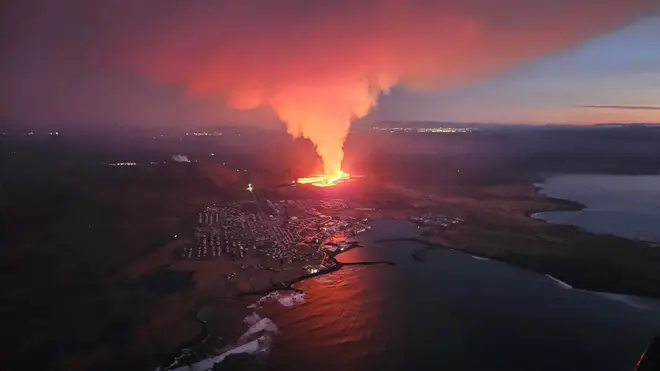
Shelagh Fogarty 1pm - 4pm
15 January 2024, 09:42 | Updated: 15 January 2024, 10:41

Entire houses have been engulfed in fire after the dramatic volcanic eruption in Grindavik, southwest Iceland, in the early hours of Sunday morning.
Aerial footage shows homes in the small fishing town, situated around 25 miles away from Iceland's capital Reykjavík, being surrounded by fiery rivers of lava before being consumed by the scorching inferno.
The eruption began on Sunday morning, at around 8am local time, before a second fissure opened up at noon, with expert warning that more fissures are expected in the coming days.
The volcano, which is located on the Reykjanes peninsula, spilled lava into Grindavik, resulting in a main road into the town being cut off by lava, and residents of the town being evacuated.
The country has raised its alert level to "emergency" - the highest of the three-level scale which indicates the threat to people, communities, property or the environment.
Met Office expert Benedikt Halldórsson told Icelandic news channel RUV: “I don't think it's possible to imagine anything worse than it [the volcano] erupting in a settlement and lava flowing onto houses.”
Read more: Iceland volcano erupts again forcing residents to evacuate just weeks after returning home
Read more: Gas pollution 'likely' in Icelandic capital after huge volcanic eruption, national forecaster warns

Volcano erupts in south-western Iceland
‼️RAGANRÖK – The magma has inhaled entire houses in Grindavik, Iceland, after the recent volcanic eruption, - reportedly from January 14, 2024 pic.twitter.com/RBsEs8GcOq
— Mister J. - مسٹر جے (@Angryman_J) January 15, 2024
No disruption for air travel has been reported, with both domestic and international flights from nearby Keflavik Airport operating as normal.
Professor Matthew Watson from the University of Bristol told LBC: "The people of the town were evacuated an hour before the eruption started and authorities moved quickly to save heavy equipment used to build defences around the town.
"These defences appear to have worked somewhat, with significant volumes (but not all) of the material being deflected".
In a live address to the nation on Sunday evening, Iceland's President Gudni Johannesson urged citizens to "stand together and have compassion for those who cannot be in their homes".
Johannesson warned “Anything can happen,” according to AFP news agency, suggesting that the volatility of the situation remains a cause of serious concern.
Prime Minister Katrín Jakobsdóttir said the government would be organising a meeting today to discuss housing for evacuated residents.
Jakobsdóttir said: "Today is a black day for Grindavik and today is a black day for all of Iceland, but the sun will rise again".


She added: "Together we will deal with this shock and whatever may come. Our thoughts and prayers are with you."
The last time the volcano erupted was December 18, last year, which resulted in the evacuation of Grindavik's 4,000 inhabitants, as well as the closure of the popular Blue Lagoon geothermal spa.
However, residents of Grindavik were spared from the eruption last time, with lava flowing in a different direction and away from the town.
This is the fifth eruption within the Svartsengi volcanic system since 2001 after remaining dormant for 800 years.
Professor Clive Oppenheimer from the Unversity of Cambridge told LBC that Iceland could be looking at "a long period of stop-start activity" in the region.
He added: "The Icelandic civil defence authorities, emergency planners and the scientists monitoring the volcano have done an amazing job of managing this prolonged threat".
Iceland has 33 active volcano systems, making it the highest number in Europe, with the country being a hotspot for seismic and volcanic activity, as it lies between the Eurasian and North American tectonic plates, two of the largest on the planet.